
A railroad car, railcar, railway wagon, railway carriage, railway truck, railwagon, railcarriage or railtruck, also called a train car, train wagon, train carriage or train truck, is a vehicle used for the carrying of cargo or passengers on a rail transport network. Such cars, when coupled together and hauled by one or more locomotives, form a train. Alternatively, some passenger cars are self-propelled in which case they may be either single railcars or make up multiple units.

A caboose is a crewed North American railroad car coupled at the end of a freight train. Cabooses provide shelter for crew at the end of a train, who were formerly required in switching and shunting; as well as in keeping a lookout for load shifting, damage to equipment and cargo, and overheating axles.
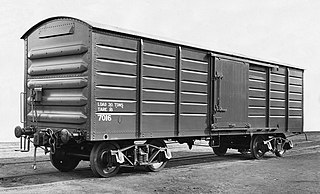
A boxcar is the North American (AAR) and South Australian Railways term for a railroad car that is enclosed and generally used to carry freight. The boxcar, while not the simplest freight car design, is considered one of the most versatile since it can carry most loads. Boxcars have side sliding doors of varying size and operation, and some include end doors and adjustable bulkheads to load very large items.

In railroad terminology, a stock car or cattle car is a type of rolling stock used for carrying livestock to market. A traditional stock car resembles a boxcar with louvered instead of solid car sides for the purpose of providing ventilation; stock cars can be single-level for large animals such as cattle or horses, or they can have two or three levels for smaller animals such as goats, sheep, pigs, and poultry. Specialized types of stock cars have been built to haul live fish and shellfish and circus animals such as camels and elephants. Until the 1880s, when the Mather Stock Car Company and others introduced "more humane" stock cars, death rates could be quite high as the animals were hauled over long distances. Improved technology and faster shipping times have greatly reduced deaths.

In United States railroad terminology, a troop sleeper was a railroad passenger car which had been constructed to serve as something of a mobile barracks for transporting troops over distances sufficient to require overnight accommodations. This method allowed part of the trip to be made overnight, reducing the amount of transit time required and increasing travel efficiency.
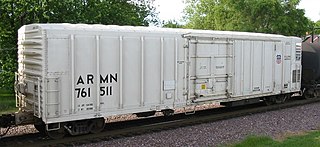
A refrigerator car is a refrigerated boxcar (U.S.), a piece of railroad rolling stock designed to carry perishable freight at specific temperatures. Refrigerator cars differ from simple insulated boxcars and ventilated boxcars, neither of which are fitted with cooling apparatus. Reefers can be ice-cooled, come equipped with any one of a variety of mechanical refrigeration systems, or use carbon dioxide or liquid nitrogen as a cooling agent. Milk cars may or may not include a cooling system, but are equipped with high-speed trucks and other modifications that allow them to travel with passenger trains.

An autorack, also known as an auto carrier, is a specialized piece of railroad rolling stock used to transport automobiles and light trucks. Autoracks are used to transport new vehicles from factories to automotive distributors, and to transport passengers' vehicles in car shuttles and motorail services, such as Amtrak's Auto Train route.
The USRA standard locomotives and railroad cars were designed by the United States Railroad Administration, the nationalized rail system of the United States during World War I. 1,870 steam locomotives and over 100,000 railroad cars were built to these designs during the USRA's tenure. The locomotive designs in particular were the nearest the American railroads and locomotive builders ever got to standard locomotive types, and after the USRA was dissolved in 1920 many of the designs were duplicated in number, 3,251 copies being constructed overall. The last steam locomotive built for a Class I railroad in the United States, an 0-8-0 built by the Norfolk and Western Railway in 1953, was a USRA design. A total of 97 railroads used USRA or USRA-derived locomotives.
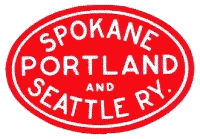
The Spokane, Portland & Seattle Railway was a railroad in the northwest United States. Incorporated in 1905, it was a joint venture by the Great Northern Railway and the Northern Pacific Railway to build a railroad along the north bank of the Columbia River. The railroad later built or acquired other routes in Oregon. The SP&S was merged into the Burlington Northern in March, 1970. Remnants of the line are currently operated by BNSF Railway and the Portland and Western Railroad.

Gustavus Franklin Swift, Sr. was an American business executive. He founded a meat-packing empire in the Midwest during the late 19th century, over which he presided until his death. He is credited with the development of the first practical ice-cooled railroad car, which allowed his company to ship dressed meats to all parts of the country and abroad, ushering in the "era of cheap beef." Swift pioneered the use of animal by-products for the manufacture of soap, glue, fertilizer, various types of sundries, and even medical products.
The Mather Stock Car Company was a U.S. corporation that built railroad rolling stock. Mather specialized in stock cars, but built other types of cars as well, including boxcars. The company was headquartered in Chicago, Illinois. Their main headquarters building, Mather Tower, built in 1928 in Chicago, still stands today. This building has the smallest floors of any of Chicago's skyscrapers.

The Wiscasset, Waterville and Farmington Railway is a 2 ft narrow gauge railway. The line was operated as a for-profit company from 1895 until 1933 between the Maine towns of Wiscasset, Albion, and Winslow, but was abandoned in 1936. Today 3.5 miles (5.6 km) of the track in the town of Alna has been rebuilt and is operated by the non-profit Wiscasset, Waterville and Farmington Railway Museum as a heritage railroad offering passenger excursion trains and hauling occasional cargo.
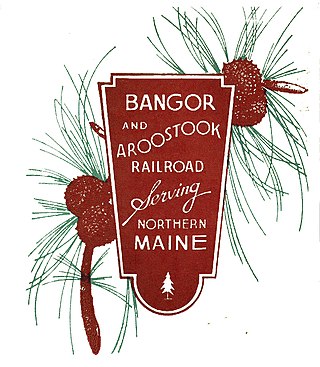
The Bangor and Aroostook Railroad was a United States railroad company that brought rail service to Aroostook County in northern Maine. Brightly-painted BAR boxcars attracted national attention in the 1950s. First-generation diesel locomotives operated on BAR until they were museum pieces. The economic downturn of the 1980s, coupled with the departure of heavy industry from northern Maine, forced the railroad to seek a buyer and end operations in 2003. It was succeeded by the Montreal, Maine and Atlantic Railway.
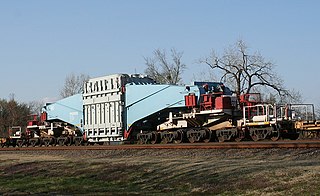
A Schnabel car or Schnabel wagon is a specialized type of railroad freight car. It is designed to carry heavy and oversized loads in such a way that the load makes up part of the car. The load is suspended between the two ends of the cars by lifting arms; the lifting arms are connected to an assembly of span bolsters that distribute the weight of the load and the lifting arm over many wheels.

Rail freight transport is the use of railways and trains to transport cargo as opposed to human passengers.
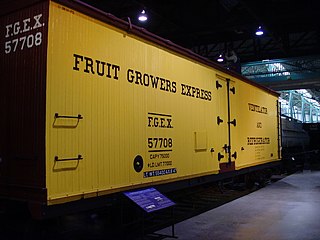
Fruit Growers Express (FGE) was a railroad refrigerator car leasing company that began as a produce-hauling subsidiary of Armour and Company's private refrigerator car line. Armour controlled both the packing operations and the transport insulated railroad car line, and its customers had complained they were overcharged. In 1919 the Federal Trade Commission ordered the company's spinoff of Fruit Growers Express for antitrust reasons, which was accomplished by 1920.
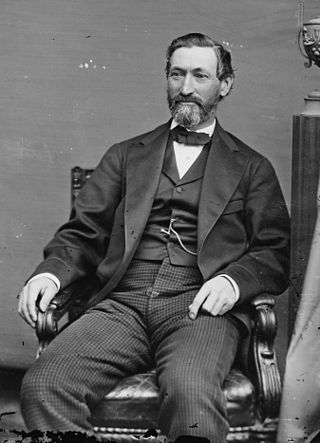
William Henry Barnum was an American politician, serving as a state representative, congressman, U.S. senator, and finally as chairman of the Democratic National Committee. He was also known as "Seven Mule Barnum".
The West India Fruit and Steamship Company operated a railcar ferry service between the Port of Palm Beach, Florida, and Havana, Cuba, from shortly after World War II until deteriorating relations between the United States and Cuba culminated in the United States embargo against Cuba. The company offered six of its ferries for sale in June 1961, citing the fact that "trade had dwindled to the vanishing point" and service ceased in August 1961.

A freight house, in North America, is a building owned and operated by a railroad for receiving, loading, unloading, and temporary storage of less-than-car load (LCL) freight. Having a protected area for temporary freight storage improves efficiency by allowing railroads to accommodate customers' delivery and pickup schedules without leaving boxcars idle at loading points and destinations. A typical freight house has at least one trackside door with one or more doors for trucks or wagons to load and unload on the opposite side of the building.

Incentive per diem (IPD) was a program created in the United States in 1970 to encourage railroads to purchase new boxcars. Established by the Interstate Commerce Commission (ICC), a regulatory agency overseeing railroads, the program offered significant payments to railroads that purchased new boxcars. Intended to relieve a perceived shortage of boxcars, the program was instead exploited by small railroads who worked with financial firms to exploit a loophole in the program and purchase large numbers of boxcars that generated extra revenue and were exempt from normal shipping rules. As many as 40,000 boxcars were built as a result of the program.


















